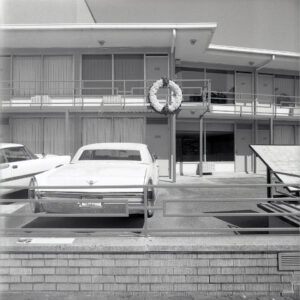On the Road with Jonathan Calm
In 2016, Jonathan Calm was invited to serve as the photographer for a BBC Radio documentary about the The Green Book: a guide book—first published by Victor H. Green in 1936 and updated annually until 1967—for black travelers making their way through the segregated U.S., listing hotels, lodging houses, restaurants, gas stations, taxi services, beauty parlors, barbershops, and other safe havens.
Calm agreed, and joined Alvin Hall and the crew for a week and a half, traveling from Tallahassee, Florida to Ferguson, Missouri. Calm wasn’t familiar with The Green Book, and he’d never before been to the South. As soon as he arrived, though, he knew: this was his project. “I found freedom in the South,” Calm told us. “I couldn’t take a bad photograph!”

Jonathan Calm, “Green Book (Lorraine Motel I),” 2016
Since that trip, Calm has visited numerous sites listed in The Green Book, has taken thousands of photographs, and is only, he thinks, halfway “done.” His Green Book photographs possess a certain distance—in the studio Calm jokes that if he could gain access to Google’s vast street view catalogue he wouldn’t even need to travel—but behind that distance is the history and experience of race in America, the erasure of people of color, their histories, and their spaces from our maps of the nation, and the systemic exclusion and expulsion of black people from one of the foundational modern American myths: the freedom of the open road. The road, Calm explains, has never been safe for Black travelers—a fact the mere existence of The Green Book attests to, and which is a theme running through several bodies of Calm’s work, including the series Double Vision and Travel is Fatal to Prejudice.
While here at Headlands, Calm is working on new portraits in the landscape, with themes related to the visibility of mobile people of color and the anomaly of a black landscape photographer. Along with new work, Calm has been sifting through the thousands of photographs that he took while traveling to Green Book sites in the Pacific Northwest and between the Bay Area and Reno, Nevada, working toward an exhibition in the fall of 2020 at Rena Bransten Gallery. Though the photographs capture a specific site, for Calm the work is as much about the road itself; he shoots quickly, eschewing the tripod—and the feeling of vulnerability that comes with being encumbered—in favor of mobility, moving on as soon as he feels he’s caught the image he came for.
